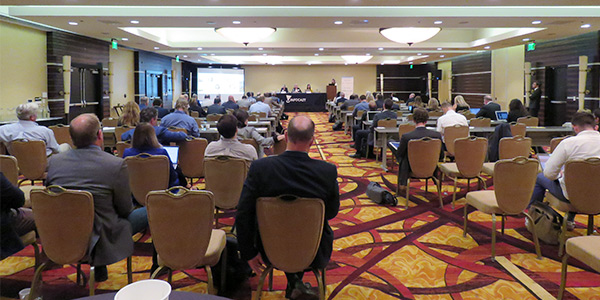By Hudson Sangree
LOS ANGELES — To open his presentation at Infocast’s California Energy Summit last week, Marty Niles, a veteran lineman and founder of Cantega Technologies, played a clip from the quiz show “Jeopardy!”
The deputy director of the National Security Agency said the No. 1 threat to the U.S. electrical grid came from these climbing rodents, host Alex Trebek said.
“What are squirrels?” a contestant answered correctly.
Niles, whose company makes Greenjacket covers for electrical equipment, then showed a series photos and videos in which birds and animals had become trapped in substations, transformers and conductors, sparking fires and explosions. Greenjacket’s covers could help prevent fires caused by animal damage, Niles said.
“We’re just another tool in the toolbox with regard to the fire suppression effort,” he said.
Niles’ presentation was one of several talks at this year’s summit that focused on the utility-sparked wildfires that have ravaged California in recent years. (See Calif. Wildfire Relief Bill Signed After Quick Passage.)
Microgrids and Wildfires
In a panel on wildfire prevention, panelists discussed the need for microgrids to maintain essential services — such as emergency shelters at schools — during incidents in which the main power supply was switched off or damaged.
Craig Lewis, executive director of the nonprofit Clean Coalition, said smaller-scale grids powered by renewable energy are essential, with California facing greater threats from massive fires fueled by climate change.
In the fire-prone Santa Barbara area, he said, electric infrastructure is crucial for pumping water uphill from coastal areas to battle mountain blazes.
“That water is absolutely critical for fighting fires,” he said.
Tim Hade, co-founder and COO of Scale Microgrid Solutions, said California is “on the path to having the most expensive and least reliable electricity in the United States” because of the wildfire threat.
Utilities have been using public safety power shutoffs to prevent their equipment from sparking fires during periods of low humidity and high winds.
With power shut off to entire communities, having microgrids as backup is crucial, Hade and others said. Those who depend on medical devices, for instance, can’t go without electricity.
“We need to reinvent electricity,” Hade said. “That’s the challenge.”
Inspecting Poles and Undergrounding Lines
On the same panel, Sumeet Singh, vice president of Pacific Gas and Electric’s community wildfire safety program, said the bankrupt company has been making strides to head off wildfires before they start.
The company is widely blamed for causing the Camp Fire, which burned much of the town of Paradise in November, killing 85 people. PG&E equipment also sparked devastating wildfires in Northern California’s wine country in 2017 and in the Sierra Nevada foothills in 2015, the California Department of Forestry and Fire Protection has said.
PG&E declared bankruptcy in January, citing billions of dollars in fire liability. (See PG&E’s Bondholders Push $30 Billion Investment Plan.)
The company recently issued a press release outlining the accomplishments of the program Singh heads. They included visual inspections of 96% of about 50,000 transmission structures in high fire-risk areas, the utility said. The company also said it had inspected 222 substations and nearly all its 700,000 distribution poles in high-risk fire areas.
PG&E has installed 430 weather stations since 2018, including 231 so far this year, it said.
In Paradise, PG&E is undergrounding new power lines where it makes most sense, Singh said. It’s also replacing wooden poles with composite structures. During the fast-moving Camp Fire, wooden poles toppled, blocking escape routes for some who died.
“I wish we could say undergrounding is a panacea,” Singh said. But it’s costly and time consuming, and while 1 mile of conductor is being undergrounded, many other miles of line remain at risk.
Another panelist, Diane Moss, founder and director of the Renewables 100 Policy Institute, said her friends from Germany were amazed to see overhead power lines in California that “reminded them of Africa.” Germany undergrounded most of its lines after World War II, she said.
“Are we going to have to wait to do that?” Moss asked.
Abe Powell, chairman of the Montecito Fire Protection District Board, said he understood undergrounding 200 miles of line in Paradise would cost about $1 billion. Montecito, near Santa Barbara, was ravaged by the Thomas Fire in late 2017 and ensuing mudslides in early 2018. The death toll was 23. Southern California Edison has admitted at least partial responsibility. (See Edison Takes Partial Blame for Wildfire in Earnings Call.)
Powell, however, questioned whether undergrounding lines for one community is the best use of $1 billion.
“We haven’t thought this through all the way,” he said.





